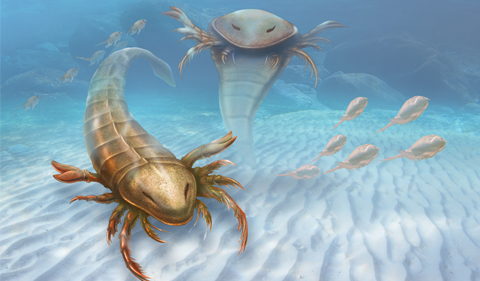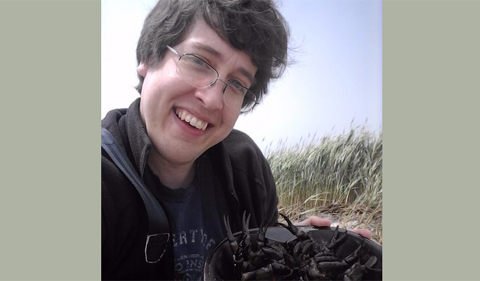The Geological Sciences Colloquium Series presents Dr. James Lamsdell on “Exploring environmental drivers of morphological change in horseshoe crabs and sea scoprions” on April 20 at 2 p.m. in Clippinger 205.
Lamsdell is Assistant Professor at the West Virginia University Department of Geology and Geography.

Eurypterids
Abstract: The importance of both intrinsic biological and external environmental factors in defining macroevolutionary patterns has been recognized since its popularization by G. G. Simpson. However, there is still much discussion about how the genealogical and ecological hierarchies interact, the outcome of these interactions on patterns of morphospace occupation, and the general repeatability of the evolutionary outcome of any given situation. Of particular interest are the drivers of morphological innovation and whether novel morphologies are associated with shifts in Hutchinsonian niche. Phylogenetic paleoecology, combining tree-based frameworks of relationships with geologic paleoenvironmental data, is one way to explore how clades respond to broad-scale changes in environment. Arthropods are an excellent group on which to conduct such studies due to their character-rich hard external exoskeleton. Combining studies of phylogeny, empirical morphospace, and environmental occupation, I compare variations in ecology and morphospace across the evolutionary history of two Paleozoic arthropod groups, the Eurypterida and Xiphosurida. Both groups undergo a change in evolutionary regime during the Late Devonian, linked to an ecological transition from marine to freshwater environments. In eurypterids the change manifests as a reduction in diversity with the surviving lineage exhibiting low disparity alongside a decrease in endemism, with new species exhibiting general peramorphic morphological trends. Xiphosurids, however, show the opposite trend, with the invasion of non-marine environments resulting in a shift away from bradytely and a proliferation of new pedomorphic species that occupy novel regions of morphospace. Interestingly, other xiphosurid groups that invade non-marine environments during the Mesozoic show a similar ecological pattern of differentiation, speciation and subsequent extinction. Shifts in ecology therefore have long-term impacts on a lineage’s macroevolutionary trajectory, with eurypterids experiencing a permanent shift in morphospace in response to the regime change in the Devonian. Importantly, intrinsic factors within lineages (peramorphic vs. pedomorphic trends) appear as important as external (ecologic) elements in mediating morphological innovation.




















Comments